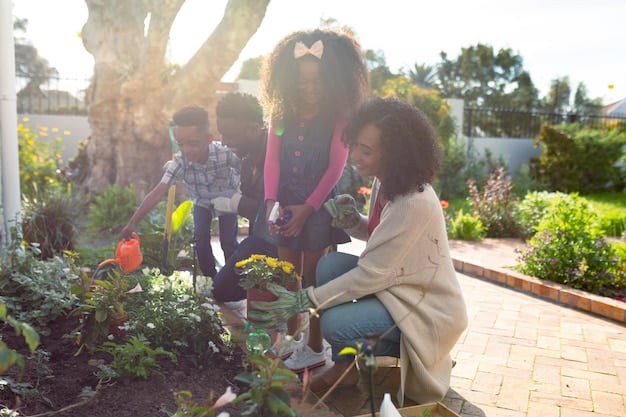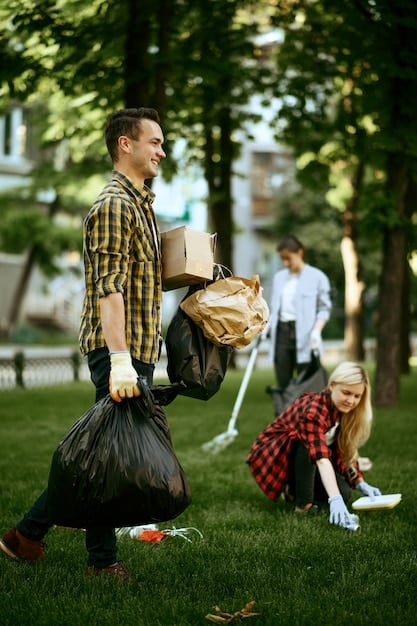Family Volunteer Day: Bond & Give Back Together

Family Volunteer Day is a perfect opportunity for families to bond and contribute to their community by engaging in meaningful activities that make a difference and create lasting memories.
Looking for a meaningful way to spend time with your family while making a positive impact? Family Volunteer Day is the perfect occasion! It’s a chance to connect with loved ones, instill values of empathy and social responsibility, and give back to your community in a fun and engaging way.
What is Family Volunteer Day?
Family Volunteer Day is more than just a day off; it’s an opportunity for families to unite in the spirit of giving. Celebrated annually, usually in November, it encourages families to engage in volunteer activities together, fostering stronger bonds and promoting a sense of community responsibility.
This special day provides a platform for families to discover ways to contribute to society, whether it’s through environmental conservation, helping those in need, or supporting local organizations. It’s a chance to make a tangible difference while creating lasting memories.
The Origins and Significance
Founded by Points of Light, Family Volunteer Day has grown into a global movement, sparking a wave of family-oriented volunteerism across the United States and beyond. It highlights the importance of families working together to address community challenges and instill a sense of civic duty in future generations.
Here are some key aspects of the day’s significance:
- Promotes Family Bonding: Working side-by-side on a common goal strengthens relationships and creates shared experiences.
- Instills Values: Volunteering teaches children empathy, compassion, and social responsibility.
- Community Impact: Families can make a tangible difference in their local community and beyond.
- Encourages Lifelong Service: Introducing children to volunteerism early can foster a lifelong commitment to helping others.
Ultimately, Family Volunteer Day serves as a catalyst for positive change, demonstrating the power of families working together to build stronger, more caring communities. By participating, families not only give back, but also enrich their own lives and create a legacy of service.

How Does Volunteering Benefit Families?
Volunteering together as a family offers a treasure trove of benefits that extend far beyond the immediate act of service. It’s an experience that can strengthen family bonds, instill important values, and contribute to personal growth.
Engaging in volunteer activities not only helps those in need but also provides valuable opportunities for families to connect, communicate, and learn from one another.
Strengthening Family Bonds
When families volunteer together, they create shared experiences and memories that can last a lifetime. Working towards a common goal fosters teamwork, communication, and a deeper understanding of each other’s strengths and weaknesses. These shared experiences create a bond that strengthens relationships within the family unit.
Instilling Important Values
Volunteering is a powerful tool for teaching children about empathy, compassion, and social responsibility. By witnessing their parents’ commitment to helping others, children learn the importance of giving back and the positive impact they can have on the world around them.
Personal Growth
Volunteering can be a transformative experience for both adults and children. It can boost self-esteem, provide a sense of purpose, and expand horizons by exposing individuals to different cultures, perspectives, and challenges. Volunteering also offers opportunities to develop new skills, build confidence, and broaden one’s understanding of the world.
In conclusion, volunteering as a family is a rewarding experience that offers numerous benefits. It’s an opportunity to connect, learn, and make a difference while strengthening bonds and fostering personal growth.
4 Ways to Give Back to Your Community as a Family
When planning a **Family Volunteer Day**, it’s helpful to have some concrete ideas to get started. Here are four impactful ways your family can give back to your community:
These options are designed to highlight how giving back can be both fun and fulfilling for every family member. Now, let’s explore the possibilities!
- Serving at a Local Food Bank:
Spend a day at your local food bank, helping to sort, pack, and distribute food to those in need. This is a practical hands-on way to directly impact families in your community who are facing food insecurity. Children can help with age-appropriate tasks, and you can explain the important cause to them.
- Participating in a Park or Beach Cleanup:
Take care of your environment by organizing or joining a park or beach cleanup. Collect trash, recycle materials, and contribute to a cleaner, healthier environment. This activity promotes environmental awareness and encourages responsible stewardship of our natural resources.
- Volunteering at an Animal Shelter:
If your family loves animals, volunteer at a local animal shelter. Help care for the animals by feeding them, cleaning their living spaces, and providing them with love and attention. This experience teaches compassion and responsibility towards animals in need.
- Visiting a Nursing Home or Assisted Living Facility:
Bring joy and companionship to elderly residents by visiting a nursing home or assisted living facility. Engage in conversations, play games, read aloud, or simply offer a friendly presence. This act of kindness helps combat loneliness and isolation among the elderly population.
No matter which activity you choose, Family Volunteer Day is an opportunity to make a positive impact on your community while spending quality time with your loved ones. These are just a few examples, and there are many other ways to get involved and give back to your community.

Tips for Planning a Successful Family Volunteer Day
Before diving into your chosen volunteer activity, a little planning can go a long way in ensuring a successful and fulfilling Family Volunteer Day experience for everyone involved.
Here are some key tips to help you plan and execute a memorable and impactful day of service:
Choosing the Right Activity
Consider your family’s interests, skills, and availability when selecting a volunteer activity. Opt for activities that align with your values and passions, and that are suitable for all ages and abilities within your family. Involving everyone in the decision making process can boost enthusiasm and commitment.
Coordinating with Organizations
Reach out to local organizations, charities, or community centers to inquire about volunteer opportunities and their specific needs. Schedule your volunteer day in advance and coordinate with the organization to ensure your assistance aligns with their priorities and logistical requirements.
Preparing Logistically
Prepare for your volunteer day by gathering necessary supplies, attire, and transportation arrangements. Ensure everyone is dressed appropriately for the activity, and that you have adequate water, snacks, and sun protection. Consider carpooling or using public transit to minimize environmental impact.
Debriefing and Reflection
After your volunteer day, take time to debrief and reflect on your experiences. Discuss what you learned, how you felt, and the impact you made. Use the opportunity to reinforce values of empathy, compassion, and social responsibility. Encourage ongoing volunteerism and community involvement.
By following these tips, you can ensure that your Family Volunteer Day is a rewarding and meaningful experience for everyone involved. It’s an opportunity to strengthen bonds, instill values, and give back while making a significant difference in your community.
Making Volunteerism a Family Tradition
Family Volunteer Day doesn’t have to be a one-time event; it can be the catalyst for establishing a lasting family tradition of service and giving back.
Incorporating volunteerism into your family’s routine is a powerful way to instill values, strengthen bonds, and make a lasting difference in the world around you.
Integrating Volunteerism into Your Family’s Lifestyle
Look for regular volunteer opportunities that fit your family’s schedule and interests. Whether it’s weekly, monthly, or quarterly, create a routine that makes volunteerism a natural part of your family’s lifestyle. This could involve volunteering at a local soup kitchen, tutoring underprivileged children, or visiting elderly residents at a care facility. In selecting the right opportunity for all, you are helping your family grow as a unit and providing help to people that need it.
Celebrating Special Occasions Through Service
Consider incorporating volunteerism into your family’s celebrations and holidays. Instead of exchanging gifts, organize a volunteer activity, such as packing care packages for military personnel or collecting donations for a local charity. This gives everyone an opportunity to pause and think about those who may not be as fortunate as they are.
Setting a Positive Example
Parents can set a powerful example by demonstrating their own commitment to volunteerism. Involve your children in your volunteer activities and explain why you find it important to give back. By seeing you actively engaged in making a difference, your children will be more likely to adopt a similar mindset and prioritize service in their own lives.
By embracing volunteerism as a family tradition, you not only enrich your own lives but also contribute to a more caring, compassionate, and connected community. It’s a legacy of service that will inspire generations to come.
Inspiring Stories of Families Making a Difference
Family Volunteer Day is often filled with countless stories of families creating an impact in their communities. Let’s take a look at some real-world examples of how families are making a difference through volunteerism.
These stories are a source of inspiration, and they illustrate the transformative power of families working together to address community challenges and make a positive impact.
The Smith Family’s Environmental Initiative
The Smith family in California organized a community-wide cleanup of their local beach. They rallied friends, neighbors, and local businesses to participate, collecting tons of trash and debris, and contributing to a cleaner, healthier environment for all.
The Johnson Family’s Tutoring Program
The Johnson family in New York started a tutoring program for underprivileged children in their neighborhood. They provide free tutoring in math, reading, and writing, helping kids improve their academic performance and reach their full potential.
The Davis Family’s Nursing Home Visits
The Davis family in Texas regularly visits a nearby nursing home, bringing joy and companionship to elderly residents. They engage in conversations, play games, and provide a much-needed sense of connection and community.
These are just a few examples of the many ways families are making a difference in their communities through volunteerism. These stories reveal the transformative power of families working together to effect positive change and create a brighter future for all.
| Key Point | Brief Description |
|---|---|
| 🤝 Family Bonding | Volunteering together creates shared experiences and strengthens relationships. |
| 🌱 Instilling Values | Volunteering teaches empathy, compassion, and social responsibility to children. |
| 🌍 Community Impact | Families can make a tangible difference in their local community. |
| 😊 Personal Growth | Volunteering can boost self-esteem and expand horizons for all family members. |
Frequently Asked Questions
▼
The main goal of Family Volunteer Day is to encourage families to engage in volunteer activities together, promoting stronger bonds, instilling values of empathy, and making a positive impact on their communities.
▼
Family Volunteer Day is usually celebrated annually in November. Check with local organizations or charities for specific dates and events near you as they may vary each year.
▼
Families can participate in a variety of volunteer activities, such as serving at a local food bank, participating in park cleanups, volunteering at animal shelters, or visiting nursing homes to spend time with elderly residents.
▼
Volunteering can strengthen family bonds, instill important values such as empathy and social responsibility, and contribute to personal growth for both adults and children, creating a legacy of service for future generations.
▼
Families can integrate volunteerism into their lifestyle by looking for regular opportunities that fit their schedule, celebrating special occasions through service, and setting a positive example by demonstrating their own commitment to volunteer work.
Conclusion
Family Volunteer Day is a unique opportunity for families to bond, to teach the importance of community, and to help those in need. These memories will stay with you and your family forever, and will plant the seed of helping others in your community.





